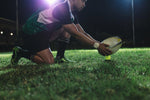
Penalty Shootouts in Rugby
, by Matthew Buckland , 5 min reading time

, by Matthew Buckland , 5 min reading time
Any tie-break situation in sports is quite extraordinary. High-pressure, exciting, stressful, and that’s just for the people watching!
Penalty shootouts are probably one of the most high-pressure situations a player faces. Composure is key, and failure can result in huge losses.
In rugby, penalty shootouts are incredibly rare, but they do happen. Not to be confused with penalties given during the game, which are very different to a shootout situation.

The referee can award a penalty when a player breaks the rules, which is known as an infringement. Some infringements that may result in a penalty include:
Referees use their discretion when it comes to infringements. They may not always penalise these infringements if they conclude that the offending player had no intent to break the rules or was not affecting the game. For example, if a player was in an offside position but not interfering with play.
A referee may also issue a warning to teams before penalising them. This reduces the need for stoppages in the game, allowing it to flow, which is appreciated by players and spectators alike.
The team awarded the penalty restarts the game. There are four ways to do so:

The penalty shootout is a rare beast in rugby and a contentious subject for many fans and pundits. It seems there isn’t a particularly fair way for penalty shootouts to be carried out in rugby. The few times a penalty shootout has occurred, the methods have varied.
After extra time, the teams were still tied on 26 each, so the match came down to a penalty shootout. In this case, each penalty kick was taken directly in front of the posts on the 22-metre line, with a different kicker each time. Five players were selected from each team to kick. After five, there was still a tie, so the penalties went to sudden death. After a gruelling contest, Leicester came out on top, winning the shootout 7-6.
In this penalty shootout, five players each took turns taking a kick once again. However, instead of shooting from the same spot on the 22, the players kicked from different positions along the line. After five kicks each, a sudden death ensued, eventually letting Argentina get the better of the young Wales side, beating them 9-8.
The most recent, and perhaps most complex penalty shootout yet, came from the Champion’s Cup earlier this year. This time, only three kickers were nominated from each team, and they kicked from various positions:
Eventually, Toulouse beat Munster 4 to 2.
Following Munster’s recent loss to Toulouse on penalties, World Rugby has spoken of looking into a new decider for games stuck on a draw where a winner must be decided.
One format that has been suggested is a one-on-one match-up between an attacker and a defender.
The attacking player would receive the ball 30 metres from the opposition’s try line, with a defender from this team standing on their 5-metre line. The attacker has 10 seconds to score. If they manage it, the opposition team has to match it. Otherwise, they lose.
There’s no easy way to decide on a winner in a rugby tiebreak situation. Many fans deem penalty shootouts unfair, not only in rugby but in other sports too. Fortunately, tiebreaks don’t come around too often in rugby, but let's hope we can find a reliable solution when they do!
Visit the Absolute Rugby website to shop our extensive range of rugby clothing, footwear and training gear. For more rugby news and discussion, check out our blog.
Back to Rugby: Kit Bag Essentials
The Top 10 Best Rugby Captains of All Time


